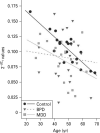GABA-related transcripts in the dorsolateral prefrontal cortex in mood disorders
- PMID: 21226980
- PMCID: PMC3388740
- DOI: 10.1017/S1461145710001616
GABA-related transcripts in the dorsolateral prefrontal cortex in mood disorders
Abstract
Reduced cortical γ-aminobutyric acid (GABA) levels and altered markers for subpopulations of GABA interneurons have been reported in major depressive disorder (MDD) by in-vivo brain imaging and post-mortem histological studies. Subgroups of GABA interneurons exert differential inhibitory control on principal pyramidal neurons and can be identified based on the non-overlapping expression of the calcium-binding proteins parvalbumin (PV) or calretinin (CR) or the neuropeptide somatostatin (SST). As altered markers of GABAergic functions may also be present in bipolar disorder (BPD), the specificity of particular GABA-related molecular deficits in mood disorders is not known. We used real-time quantitative polymerase chain reaction (qPCR) to assess expression levels of two GABA synthesizing enzymes (glutamate decarboxylase; GAD65 and GAD67) and of three markers of GABA neuron subpopulations (PV, CR, SST) in the dorsolateral prefrontal cortex (DLPFC; Brodmann area 9) in triads (n=19) of control subjects and matched subjects with BPD or MDD. BPD subjects demonstrated significantly reduced PV mRNA, trend level reduction in SST mRNA and no alterations in GAD67, GAD65, or CR mRNA levels; MDD subjects demonstrated reduced SST mRNA expression without alterations in the other transcripts. The characteristic age-related decline in SST expression was not observed in MDD, as low expression was detected across age in MDD subjects. After controlling for age, MDD subjects demonstrated significantly reduced SST mRNA expression. Decreased SST levels in MDD were confirmed at the protein precursor level. Results were not explained by other clinical, demographic or technical parameters. In summary, MDD was characterized by low DLPFC SST, whereas decreased PV mRNA appears to distinguish BPD from MDD.
Figures





References
-
- Akbarian S, Huang HS. Molecular and cellular mechanisms of altered GAD1/GAD67 expression in schizophrenia and related disorders. Brain Research Reviews. 2006;52:293–304. - PubMed
-
- Ansorge MS, Zhou M, Lira A, Hen R, et al. Early-life blockade of the 5-HT transporter alters emotional behavior in adult mice. Science. 2004;306:879–881. - PubMed
-
- APA . Diagnostic and Statistical Manual of Mental Disorders. 4th edn. American Psychiatric Association; Washington, DC: 1994.
-
- Beasley CL, Zhang ZJ, Patten I, Reynolds GP. Selective deficits in prefrontal cortical GABAergic neurons in schizophrenia defined by the presence of calcium-binding proteins. Biological Psychiatry. 2002;52:708–715. - PubMed
-
- Cahir M, Costello I, King DJ, Reynolds GP. Chronic haloperidol or clozapine treatment does not alter parvalbumin immunoreactivity in the rat frontal cortex or hippocampus. Neuroscience Letters. 2005;373:57–60. - PubMed
Publication types
MeSH terms
Substances
Grants and funding
LinkOut - more resources
Full Text Sources
Other Literature Sources
Medical
Research Materials

